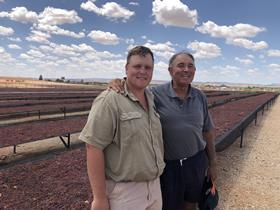
South African raisin growers are adopting new drying techniques in a bid to maximise their crop and avoid food safety issues as the sector looks to boost exports in various markets.
Increasingly, growers in the Orange Valley region are using elevated nets to dry their fruit since it reduces crop losses if it rains, allowing the rainwater to drip through.
With the fruit off the ground, there is also a reduced the risk of rocks, thorns or other objects being blown onto the fruit while it dries under the sun.
Most growers in the area still lay their grapes out on concrete slabs, however long strips of raised netting are being adopted by more and more growers following their introduction four years ago.
The method is more or less unique to South Africa, with Turkey favouring concrete slabs and California drying the majority of its raisin grapes on the vine amid labour shortages.
Turkey and the US are South Africa’s main global competitors in raisin exports, but the African country hopes production techniques like this will help give it an advantage over its rivals as it strives for greater market share in the UK, Japan and China among other countries.
Gerrit Nel of Perde Eiland Boerdery said it takes about four days longer to dry raisins on raised nets than on concrete slabs, but better ventilation of the fruit helps maximise product quality and avoid mould spreading if it rains.
Elevated drying is particularly important to Japanese importers who place extreme importance on food safety and hygiene and are said to be very concerned about stones or other objects making their way into the fruit.
The promotional body for South African raisins, Raisins South Africa, is looking to do research into how growers should best configure their drying infrastructure.
This season the country’s raisin-growing heartland along the Orange River was hit by the heaviest rainfall it has seen for six years and growers using elevated nets appear to be experiencing fewer quality issues or product losses.



